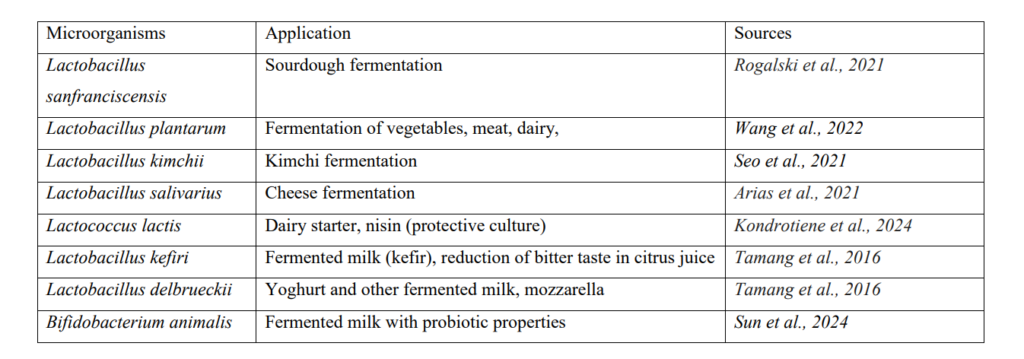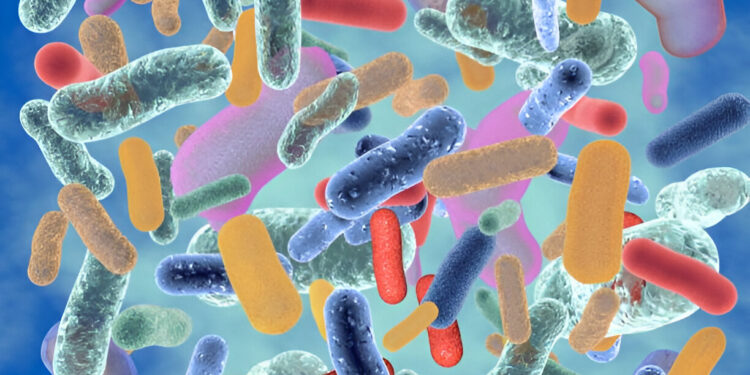Babatuyi Y. C.&1
Department of Nutrition and Dietetics, Federal University of Technology Akure, Nigeria
Corresponding Author Email: cybabatuyi@futa.edu.ng
Abstract
Microbes are critical fundamental tools in food microbiology that drive food production through fermentation, especially in sub-Saharan Africa and Asia continents. This has helped in the production of different food products, thereby making raw food materials such as legumes, roots, and cereals liable to the opening of the surface by metabolic activities of inherent microbiota to enhance more digestibility for the body to utilize. Apart from enhancing the nutritional status, invariably as value addition, some products function in amelioration of some ailments, especially non-communicable diseases. Food availability is one of the factors sustaining the world, and with the help of microbes, more food production is achievable. The use of microbes in food production has not been exploited enough as more are still needed in order to alleviate poverty and insecurity, as well as using functional food as therapy in amelioration of some ailments. The world is changing from the consumption of artificial or unhealthy food to natural or healthy safe to consume functional food. This paper discusses both the nutritional and functional food products from farm to fork, the challenges in using microbes for food production, and the procedures with likelihood way(s) to embrace food microbiology through microbes.
Keywords: Microbes, Food production, Food safety and Nutritional and Functional foods.
1. Introduction
Microorganisms are essential in life; without them, life would not exist. They perform great positive functions, especially in the area of food microbiology. Food microbiology is part of microbiology that relate and ensuring food production from ages past (Ray & Joshi, 2014). Fermentative microorganisms are the bedrock of food production that do involve in food fermentation especially the probiotics and those generally regarded as safe (GRAS) to enhance food production. Many researchers have developed novel food products using fermentative microorganisms posing no health challenges (Voidarou et al., 2020). In Africa, majority of food products are through fermentation, and this has greatly helped in food security and food safety (Obafemi et al., 2022).
Fermentation of foods has been reported by archivists to have dated back to pre-Hispanic Mexico between 1500 BC and 2000 BC (Anagnostopoulos & Tsaltas, 2019), with indigenous methods to include smoking, salting and drying. These methods have been predicted to start with cuisines and food from China. It is one of the processing operational units for food processing and considered to be a traditional method, but with the technological advancement, it has gained wide recognition and acceptance as a modern way for food processing. This has precisely translated from the formation of genetic mutation and selection into metabolic engineering known as precise fermentation (Graham & Ledesma-Amaro, 2023).
Microbial food fermentation development is the application of science and technology for food production and processing of enormous food products in liquid, semi-solid and solid-state. These have improved the nutritional quality by having high-value additions, and some serve as functional food to ameliorate some non-communicable diseases (Babatuyi et al., 2023) in ensuring food security, sustainability and wealth creation. These have resulted into change in the composition of the products and sensory evaluations, such as food condiments, cheese, bread, alcoholic and non-alcoholic beverages. (Chilton et al., 2015). Microbial food fermentation has been reported to contribute to economic growth worldwide (Materia et al., 2021) and also assist in the prevention of spoilage of raw food samples after post-harvesting, which would have resulted in post-harvest loss with the efforts of the farmers and thereby could pose negative economic growth (Materia et al., 2021). These problems are peculiar not only to Nigeria but also globally.
This book chapter focuses on the application of microbes in food production with inherent microbes and as starter culture (s), nutritional and functional roles in the past, current and future. Spoilage and pathogenic are major factors that are also reviewed and fermented foods often consumed are also included.
2. Healthy Foods
Healthy foods are being produced through microbes especially where the fermentative microbiota are monitored to prevent spoilage and pathogens. Spoilage microorganisms easily contaminate most perishable foods like veggies and protein-based foods due to their food compositions. These reduce the shelf life sustainability and are easily prone to contamination. Meanwhile, some traditionally produced foods appear spoilt (fermented condiments like soybeans, ‘iru, and ‘ogiri’ ) but are different from those that are naturally spoilt, i.e. the colouration on bread with different colours and ropiness of bread. The domination of Lactic acid bacteria (LAB) in food provides safety as it coordinates the metabolic activities of other microbes in the substrate to ensure safety (Gholami-Shabani et al., 2024).
2.1 Microbes and Food Production
Food production by inherent microorganisms cut across all food classes, such as cereals, legumes, roots, veggies, and alcoholic and non-alcoholic beverages. Some of these foods do not have nutraceuticals but improve quality, mouthfeel, appearance, digestibility and overall sensory acceptability, while some do have nutraceuticals and functional abilities that can function in amelioration of oxidative–related diseases. The clarion call for healthy foods facilitated this, which has recorded positive results for management and prevention.
The application of different microbes with different categories of food classes are stated below:
Table 1: Some Healthy Foods with and without Nutraceutical

2.2 Microbes and Food Fermentation
Food fermentation has been reported to date back to pre-Hispanic Mexico between 1500 BC and 2000 BC (Anagnostopoulos & Tsaltas, 2019). This was in the era when foods are processed in traditional ways to include sun drying and soaking, before modern methods were employed with the knowledge of science and technology to improve the processing and ensure value
addition to the quality of the products. Food products such as cereal-based products, starch-based
products, plant and animal protein-based products, fruits and vegetables, and alcoholic and non-
alcoholic beverages have been improved through microbial fermentation. Lactic acid bacteria (LAB) are a special set of microbial biomass having probiotics that are natural to them. Some examples are found mainly in cereal-based and protein-based foods. During fermentation, they are easily synthesized to inhibit spoilage and pathogenic microorganisms from thriving in the substrate. Their presence in food projects that food safe is to consume, apart from enhancing the food nutrition and other benefits. They can be re-isolated from the food and employed as a starter culture. Some LAB in food products and additives are listed below:
Table 2: Specific Food Production with LAB

2.3 Microbes and Food Enzymes
Microbes are naturally involved in food production through metabolic activities of inherent/microflora that can be separated to serve as starter culture (s). The enzymes involved in the biochemical process can be separated and used for another product without involvement with the parent microbes (Shukla et al., 2023). Enzymes’ involvement in food production causes ease of production with conservation (saver) of energy, which speeds up production and is cost-effective. The use of enzymes is increasing and has helped to diversify into different food products and production (Kumar et al., 2024). Industries are maximizing the use for massive production to alleviate food shortages and control food security globally. This has helped develop an improved food quality with improved texture, high consistency in mouthfeel and a wide variety of food products. The presence of enzymes in food do speed up food processing with less energy consumption. Some of the microbial enzymes commonly used in food industries include pectinases, lipases, laccases, celluloses, lactases, and phytases (Shukla et al., 2023; Nigam, 2013), and their applications are listed below:
Table 3: Some Enzymes Produced from Microbes

2.4 Microbes and Food-borne Diseases
Factors such as spoilage and pathogenic microorganisms are essentially considered even those considered as Generally Regard As Safe (GRAS) during food production by the use of microbiota. These have been major concerns to the food microbiologists and the producers as quality assurance of such food products and their safety. Improper storage of raw food usually affects the end products, giving room for spoilage and pathogenic microorganisms to infest it and, during this, some mycotoxin/toxin could have been released, which can only be detected (Cao et al., 2023; Gholami-Shabani et al., 2017). Processing of food products with toxins will cause food-borne illness and, at the same time, spoilage. This is why food processors or handlers should ensure proper storage of raw foods. Food spoilage results when the handling is not processed in hygienic conditions, which starts from not ensuring aseptic conditions, improper sorting and washing of the raw food before processing with unclean water or having faecal contamination, and the processor’s health is being compromised. Some microorganism species causing disease that can lead to food poisoning and food-borne illness include Escherichia, Listeria, Cronobacter, Salmonella, Shigella, Vibrio spp, and Campylobacter. (Suzz and Corsetti, 2020).
Packaging materials have been researched to contribute 20-30% source of the contamination (Schmid et al., 2023). Preventive measures such as the practice of HACCP (Hazard and Analysis Critical Control Point) have effectively controlled food spoilage and food-borne illness to a reasonable point since microbes are ubiquitous in nature (Gupta et al., 2016).
Table 4: Some Pathogenic Microbes Associated with Food Products

3. Conclusion
Microorganisms have been used globally for the production and making of foods, and higher technologies have been identified to overexpress their genes separately. Some have been mixed or singly employed for more production of food varieties in order to meet commercial demands and needs. Microbes have made life better in the area of food applications. The technological advancement of microbial use has led to the production of novel natural products that are acceptable globally in all classes of foods, like protein-based and cereal-based. The field of food microbiology is a revelation that has brought out different food productions with knowledge about state–of–the–art equipments in development of diverse kinds of food for different functions. Therefore, food microbiologists should still look inwardly into the production of functional foods as food therapy that can address any food-related disorder or diseases in reduction of drugs/tablets because the food functions has not been exhausted.
4. Limitations
Consumption of some genetically modified food products is still challenging due to different countries’ assertions and beliefs. The myth has not allowed such food products in circulation globally. Orientation is still needed, and some sensory organoleptic qualities like food appearances, colours, flavour, mouth feel, and texture should be enhanced. Furthermore, government policies at all levels should collaborate with the industries, educational institutions, and health sectors to ensure that food scientists’ and technologists’ efforts are supported in ensuring safe lifestyles and environments globally. Safety review of each country should be reviewed to align with global acceptability for economic development.
References
Anagnostopoulos, D. A. and Tsaltas, D. (2019). Fermented foods and beverages. In: Galanakis C.M., editor. Innovations in Traditional Foods. Woodhead Publishing; Sawston, Cambridge, UK pp. 257–291.
Arias, R., Alba, C., Calzada, J., Jiménez, L., Fernández, L., Ávila, M., Roman, M., Roman, J., Rodríguez, J. M. and Garde, S. (2024). Application of Ligilactobacillus salivarius SP36, a Strain Isolated from an Old Cheese Seal, as an Adjunct Culture in Cheesemaking. Foods, 13(14), 2296. https://doi.org/10.3390/foods13142296
Babatuyi, C. Y., Oyetayo, V. O., Akinyosoye, F. A. and Oyeleye, I. S. (2023). Anti-inflammatory and analgesic potentials of fermented Citrullus vulgaris with mutant and non-mutant strains of Bacillus subtilis to produce condiment (ogiri). Food and Humanity, 104–118. https://doi.org/10.1016/j.foohum.2023.05.008.
Bintsis T. (2017). Food-borne pathogens. AIMS Microbiology, 3(3), 529–563. https://doi.org/10.3934/microbiol.2017.3.529
Cao, J., Wang, Y., Zhou, C. & Geng, F. (2023). Editorial: Insights into the role of microorganisms on food quality and food safety. Front. Microbiolo.. 14: 1237508. https://doi.org/10.3389/fmicb.2023.1237508.
Chilton, S. N., Burton, J. P. & Reid, G. (2015). Inclusion of Fermented Foods in Food Guides around the World. Nutrients, 7: 390–404. https://doi.org/10.3390/nu7010390.
Denby, C. M., Li, R. A., Vu, V. T., Costello, Z., Lin, W., Chan, L. J. G., Williams, J., Donaldson, B., Bamforth, C. W., Petzold, C. J., Scheller, H. V., Martin, H. G. & Keasling, J. D. (2018). Industrial brewing yeast engineered for the production of primary flavor determinants in hopped beer. Nat. Commun. 9(1): 965. https://doi.org/10.1038/s4167-018-03293-x.
Franco, D. A. & Williams, C. E. (2001). Campylobacter jejuni. In: Hui YH, Pierson MD, Gorham JR, editors. Food-borne Disease Handbook. New York: Markel Dekker, Inc. pp. 83–105.
Gholami-Shabani, M., Shams-Ghahfarokhi, M., & Razzaghi-Abyaneh, M. (2024). Food Microbiology: Application of Microorganisms in Food Industry. In: Health Risks of Food Additives – Recent Developments and Trends in Food Sector. IntechOpen. http://dx.doi.org/10.5772/intechopen.109729. pp: 226
Gholami-Shabani M, ShamsGhahfarokhi M, Razzaghi-Abyaneh M. (2017). Aflatoxins and aflatoxigenic fungi in Iran: A systematic review of the past, present, and future. Mycologia Iranica. 4:65-84. https://doi.org/10.22043/ MI.2017.116760.
Graham, A.E. and Ledesma-Amaro, R. (2023). The microbial food revolution. Nat Commun 14, 2231. https://doi.org/10.1038/s41467-023-37891-1.
Gupta, A., Gupta, R. & Singh, R. L. (2016). Microbes and Environment. Principles and Applications of Environmental Biotechnology for a Sustainable Future, 43–84. https://doi.org/10.1007/978-981-10-1866-4_3
Harris, A. D. and Ramalingam, C. (2010). Xylanases and its application in food industry: a review. Journal of Experimental Sciences, 1(7): 01–11.
He, J., Evans, N. M., Liu, H. and Shao, S. (2020). A review of research on plant-based meat alternatives: driving forces, history, manufacturing, and consumer attitudes. Compressive. Review of Food Science and Food Safety, 19: 2639–2656.
Houbraken, J., deVaries, R. P. and Samson, R. A. (2014). Modern taxonomy of biotechnologically important Aspergillus and Penicillium species. Advances in Applied Microbiology, 86: 199-249. http://doi.org.10.1016.B978-0-12-800262-9.00004-4.
Iturriza-Gomara, M. and O’Brien, S. J. (2016). Foodborne viral infections. Current Opinion of Infectious Disease, 29:495–501. https:doi.org/10.1097/QCO.0000000000000299.
Kondrotiene, K., Zavistanaviciute, P., Aksomaitiene J. Novoslavskij, A. and Malakauskas, M. (2024). Lactococcus lactis in Dairy Fermentation—Health-Promoting and Probiotic Properties. Fermentation. 10(1):16. https://doi.org/10.3390/fermentation10010016.
Kumar, A., Dhiman, S., Krishan, B., Samtiya, M., Kumari, A., Pathak, N., Kumari, A., Aluko, R. E. andDhewa, T. (2024). Microbial enzymes and major applications in the food industry: a concise review. Food Prod Process and Nutrition, 6: 85. https://doi.org/10.1186/s43014-024-00261-5.
Materia, V. C., Linnemann, A. R., Smid, E. J. and Schoustra, S. E. (2021). Contribution of traditional fermented foods to food systems transformation: value addition and inclusive entrepreneurship. Food Sec. 13: 1163–1177. https://doi.org/10.1007/s12571-021-01185-5.
Mylona, A. E., Del-Fresno, J. M., Palomero, F., Loira, I., 󠄕Bañuelos, M. A.,Morata, A., Calderón, F., Benito, S. and Suárez-Lepe, J. A. (2016). Use of Schizo-saccharomyces strains for wine fermentation- Effect on the wine composition and food safety. International Journal of Food Microbiology, 234:62-73. https://doi.org/10.1016/j.ijfoodmicro.2016.05.023.
Mehta, A., Guleria, S., Sharma, R. & Gupta, R. (2021). The lipases and their applications with emphasis on food industry. In Microbial Biotechnology in Food and Health, 143–164. Academic Press. https://doi.org/10.1016/B978-0-12-819813-1.00006-2.
Melis, S., Pauly, A. and Delcour, J. A. (2017). Impact of lipases with different substrate specificity in wheat flour separation on the properties of the resultant gluten. Journal of Cereal Science, 77: 291–296.
Nigam P. S. (2013). Microbial enzymes with special characteristics for biotechnological applications. Biomolecules, 3(3), 597–611. https://doi.org/10.3390/biom3030597
Obafemi, Y. D., Oranusi, S. U. and Ajanaku, K. O. (2022). African fermented foods: overview, emerging benefits, and novel approaches to microbiome profiling. npj Sci Food 6, 15. https://doi.org/10.1038/s41538-022-00130-w.
Ray, R. & Joshi, V. (2014). Fermented Foods: Past, Present and Future. In Microorganisms and Fermentation of Traditional Foods; CRC Press: Boca Raton, FL, USA.
Rogalski, E., Ehrmann, M. A. and Vogel, R. F. (2021). Strain-specific interaction of Fructilactobacillus sanfranciscensis with yeasts in the sourdough fermentation. European Journal of Food Resource Technology, 247: 1437–1447. https://doi.org/10.1007/s00217-021-03722-0.
Scallan E, Hoekstra, R. M., Angulo, F.J., Tauxe, R. V., Widdowson, M. A., Roy, S. L., Jones, J. l. & Griffin, P. M. (2011). Food-borne illness acquired in the United States—major pathogens. Emergency Infectious Diseases, 17 (1):7–15. https:doi.org/10.3201/eid1701.P11101.
Schmid P. J., Maitz, S., Plank, N., Knaipp, E., Pözlzi S. and Kittinger, C. (2023). Fibre-based food packaging materials in view of bacterial growth and survival capacities. Frontier Microbiology, 14: 1099906. https://doi.org/10.3389 /fmicb.2023.1099906.
Seo, H., Bae, J. H., Kim, G., Kim, S. A., Ryu, B. H., and Han, N. S. (2021). Suitability Analysis of 17 Probiotic Type Strains of Lactic Acid Bacteria as Starter for Kimchi Fermentation. Foods, 10(6), 1435. https://doi.org/10.3390/foods10061435.
Shukla. A., Girdhar, M. and Mohan, A. (2023). Applications of microbial enzymes in the food industry. In: Karnwal, A., Mohammad Said Al-Tawaha, A.R. eds) Food Microbial Sustainability. Springer, Singapore. http://doi.org/10.1007/978-981-99-4784-3_9.
Suzz, G. and Corsetti, A. (2020). Food microbiology: The past and the new challenges for the next 10 years. Front. Microbiol. 11:237. https://doi.org/10.3389/fmicb.2020.00237.
Sun, Y., Guo, S., Kwok, L., Sun, Z., Wang, J. & Zhang, H. (2024). Probiotic Bifidobacterium animalis ssp. Lactis Probio-M8 improves the fermentation and probiotic properties of fermented milk. Journal of Dairy Science, 107(9), 6643–6657. https://doi.org/10.3168/jds.2024-24863.
Tamang, J. P., Shin, D. H., Jung, S. J. J. and Chae, S. W. (2016). Functional Properties of Microorganisms in Fermented Foods. Frontiers in Microbiology, 7: 578. https://doi.org/10.3389/fmicb.2016.00578.
Thapa, N. and Tamang, J. P. (2015). Functionality and therapeutic values of fermented foods. Health benefits of fermented foods, 111: 168.
Voidarou, C., Antoniadou, Μ., Rozos, G., Tzora, A., Skoufos, I., Varzakas, T., Lagiou, A. and Bezirtzoglou, E. (2020). Fermentative Foods: Microbiology, Biochemistry, Potential Human Health Benefits and Public Health Issues. Foods, 10(1):69. https:doi.org/10.3390/foods10010069. PMID: 33396397; PMCID: PMC7823516.
Wang, X., Tian, J. & Zhang, X. (2022). Characterization and Immunological Activity of Exopolysaccharide from Lacticaseibacillus paracasei GL1 Isolated from Tibetan Kefir Grains. Foods, 11, 3330.
About this Article
Cite this Article
APA
Babatuyi Y. C. (2025). Microbiomes and Food Microbiology. In Akinyele B.J., Kayode R. & Akinsemolu A.A. (Eds.), Microbes, Mentorship, and Beyond: A Festschrift in Honour of Professor F.A. Akinyosoye. SustainE
Chicago
Babatuyi Y. C. 2025. “Microbiomes and Food Microbiology.” In Microbes, Mentorship, and Beyond: A Festschrift in Honour of Professor F.A. Akinyosoye, edited by Akinyele B.J., Kayode R. and Akinsemolu A.A., SustainE.
Received
15 November 2024
Accepted
10 January 2025
Published
4 February 2025
Corresponding Author Email: cybabatuyi@futa.edu.ng
Disclaimer: The opinions and statements expressed in this article are the authors’ sole responsibility and do not necessarily reflect the viewpoints of their affiliated organizations, the publisher, the hosted journal, the editors, or the reviewers. Furthermore, any product evaluated in this article or claims made by its manufacturer are not guaranteed or endorsed by the publisher.
Distributed under Creative Commons CC-BY 4.0
Share this article
Use the buttons below to share the article on desired platforms.














